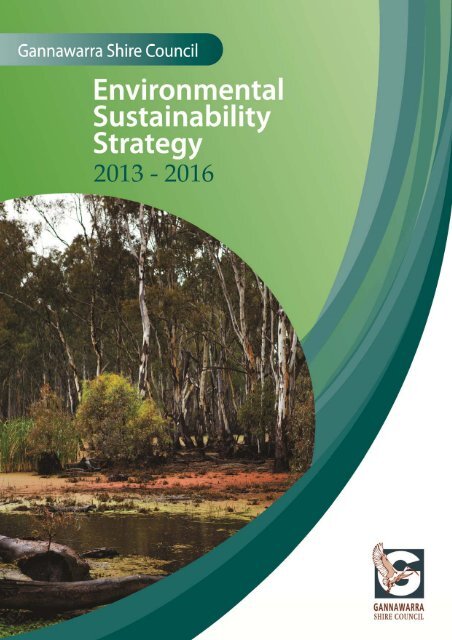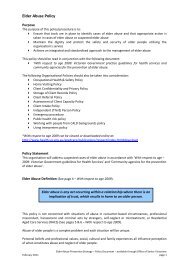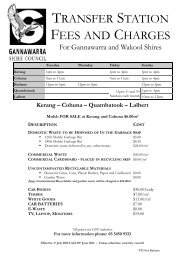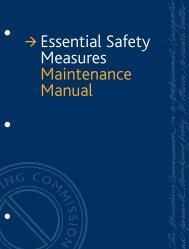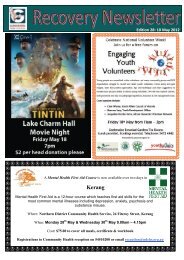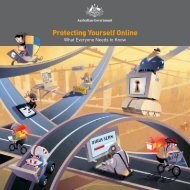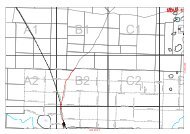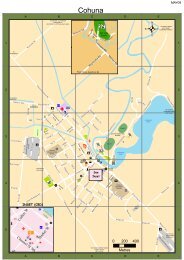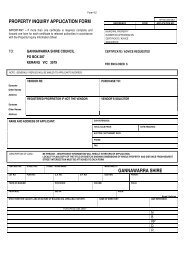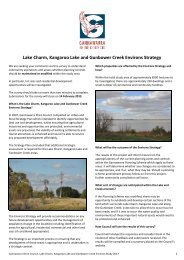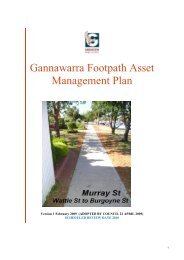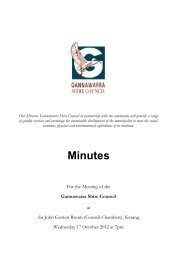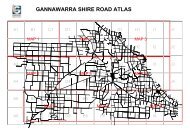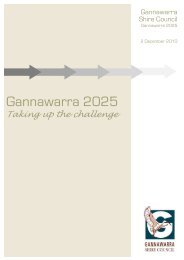Environmental Sustainability Strategy 2013 - Gannawarra Shire ...
Environmental Sustainability Strategy 2013 - Gannawarra Shire ...
Environmental Sustainability Strategy 2013 - Gannawarra Shire ...
You also want an ePaper? Increase the reach of your titles
YUMPU automatically turns print PDFs into web optimized ePapers that Google loves.
<strong>Gannawarra</strong> <strong>Shire</strong> <strong>Environmental</strong> <strong>Sustainability</strong> <strong>Strategy</strong> 2012 – 2015 P age |
Disclaimer<br />
Information contained in this document is based on available information at the time of writing. All figures and<br />
diagrams are indicative only and should be referred to as such. This is a strategic document which deals with technical<br />
matters in a summary way only. While the <strong>Gannawarra</strong> <strong>Shire</strong> Council has exercised reasonable care in preparing this<br />
document it does not warrant or represent that it is accurate or complete. Council or its officers accept no<br />
responsibility for any loss occasioned to any person acting or refraining from acting in reliance upon any material<br />
contained in this document.
Contents<br />
Executive Summary .....................................................2<br />
Introduction................................................................3<br />
The <strong>Strategy</strong> ...............................................................7<br />
Energy and Greenhouse Gas ......................................11<br />
Water.......................................................................14<br />
Waste Management and Resource Efficiency ..............18<br />
Land Use: Planning and Management .........................21<br />
Heritage ...................................................................24<br />
Community Wellbeing ...............................................26<br />
References................................................................28<br />
References................................................................29<br />
Consultations............................................................30<br />
Acronyms .................................................................31<br />
Acknowledgements<br />
<strong>Gannawarra</strong> <strong>Shire</strong> Council wishes to thank all<br />
stakeholders and community members who have<br />
taken the time to assist with the development of this<br />
strategy.<br />
This project was funded through the Victorian<br />
Government’s <strong>Sustainability</strong> Fund under the Victorian<br />
Local <strong>Sustainability</strong> Accord.<br />
<strong>Gannawarra</strong> <strong>Shire</strong> <strong>Environmental</strong> <strong>Sustainability</strong> <strong>Strategy</strong> <strong>2013</strong> – 2016 P age | i
Our Vision<br />
To embrace and support opportunities<br />
surrounding environmental sustainability,<br />
turning it to our social and<br />
economic advantage.<br />
<strong>Gannawarra</strong> <strong>Shire</strong> <strong>Environmental</strong> <strong>Sustainability</strong> <strong>Strategy</strong> <strong>2013</strong> – 2016 P age | 1
Executive Summary<br />
The <strong>Shire</strong> of <strong>Gannawarra</strong> is committed to the delivery<br />
of a sustainable future for its communities. In the past<br />
economic, environmental and social goals have been<br />
pursued in isolation from one another. However, it is<br />
recognised that the <strong>Shire</strong>’s long‐term well‐being<br />
depends as much on the promotion of a strong,<br />
vibrant society and the ongoing repair of it’s<br />
environment, as it does on the pursuit of economic<br />
development. Not only is it apparent that these issues<br />
cannot be separated, but also it is equally clear that<br />
better outcomes can be realised through holistic<br />
responses.<br />
To that end, and to complement other strategies,<br />
<strong>Gannawarra</strong> <strong>Shire</strong> has developed its first<br />
<strong>Environmental</strong> <strong>Sustainability</strong> <strong>Strategy</strong> (ESS) to identify<br />
priorities and actions that will balance the<br />
environmental, social and economic needs of the<br />
<strong>Shire</strong>.<br />
The <strong>Strategy</strong> builds upon the achievements of Council<br />
to date in improving environmental sustainability<br />
outcomes. It also provides a consistent, cohesive and<br />
prioritised approach to decision making and activity<br />
implementation to achieve environmental<br />
sustainability outcomes.<br />
The <strong>Strategy</strong> highlights the insights and themes<br />
attained through research and stakeholder<br />
consultation. Through this research, the priorities to<br />
be addressed by the <strong>Strategy</strong> have been identified and<br />
used to develop the key focus areas.<br />
The focus areas of the strategy are:<br />
1. Energy and Greenhouse Gas<br />
2. Water<br />
3. Waste Management and Resource Efficiency<br />
4. Land Use: Planning and Management<br />
5. Heritage<br />
6. Community Wellbeing<br />
From the above it is apparent that, in addition to<br />
established environmental sustainability focuses such<br />
as waste management and water, the strategy also<br />
prioritises issues that are specific to the social and<br />
economic success of the <strong>Shire</strong>, such as heritage and<br />
community wellbeing. This emphasis reflects the<br />
reality that environmental, social and economic<br />
factors are very closely interlinked in the <strong>Gannawarra</strong><br />
<strong>Shire</strong> – and joined‐up thinking and action is required<br />
to deliver sustainable change.<br />
The <strong>Strategy</strong> is to be a Council and community owned<br />
plan. Priorities and actions have been developed to<br />
address common environmental, social and economic<br />
opportunities and needs.<br />
The <strong>Strategy</strong> will remain relevant through an ongoing<br />
process of monitoring and review to ensure that both<br />
Council and community are able to respond to future<br />
opportunities and changes.<br />
It is envisaged that, through the implementation of<br />
the <strong>Strategy</strong>, the world‐class natural heritage of the<br />
<strong>Gannawarra</strong> <strong>Shire</strong>, so celebrated in this <strong>Strategy</strong>, will<br />
be protected and enhanced to the benefit of future<br />
generations. At the same time, the <strong>Strategy</strong>, along<br />
with other Council plans, will provide a framework for<br />
the ongoing management and enhancement of the<br />
<strong>Shire</strong>’s social and economic circumstances.<br />
<strong>Gannawarra</strong> <strong>Shire</strong> <strong>Environmental</strong> <strong>Sustainability</strong> <strong>Strategy</strong> <strong>2013</strong> – 2016 P age | 2
Introduction<br />
Background to the <strong>Strategy</strong><br />
In 2008, <strong>Gannawarra</strong> <strong>Shire</strong> produced its <strong>Environmental</strong><br />
<strong>Sustainability</strong> Priority Statement to meet its<br />
commitments to the Victorian <strong>Sustainability</strong> Accord.<br />
The “Accord” is a partnership initiative designed to<br />
strengthen collaborative efforts by the Victorian State<br />
Government and local governments to create better<br />
environmental sustainability outcomes at the local<br />
level.<br />
The Priority Statement is a framework document that<br />
outlines the agreed local priorities for collaborative<br />
work between the two tiers of government and<br />
contains both a set of projects undertaken by the<br />
<strong>Shire</strong> as well as outlining the key challenges and<br />
opportunities for the <strong>Shire</strong> relating to this issue.<br />
<strong>Gannawarra</strong> <strong>Shire</strong> commenced the development of its<br />
first <strong>Environmental</strong> <strong>Sustainability</strong> <strong>Strategy</strong> (ESS) early<br />
in 2012, using the 2008 Priority Statement as a<br />
launching platform. The ESS aims to bring together the<br />
work done by Council to date in the area of<br />
<strong>Environmental</strong> <strong>Sustainability</strong> and provide a consistent,<br />
cohesive and prioritised approach to decision making<br />
and activity implementation.<br />
It is envisaged that the ESS will:<br />
Increase accountability in the outcomes for<br />
environmental sustainability<br />
Guide the development of environmentally<br />
sustainable practices (for Council and the <strong>Shire</strong><br />
overall)<br />
Deliver outcomes that will enhance<br />
environmental outcomes<br />
Provide development opportunities based on<br />
environmental sustainability<br />
Strengthen community well‐being<br />
Assist effective partnerships with Local and<br />
other Government and Non‐Government<br />
agencies<br />
Definition of <strong>Environmental</strong><br />
<strong>Sustainability</strong><br />
In 1987, the United Nations, through the Brundtland<br />
Commission defined sustainable development as:<br />
“Development that meets the needs of the present<br />
without compromising the ability of future<br />
generations to meet their own needs.”<br />
A common approach to considering sustainability is<br />
through the terms of the ‘three pillars of<br />
sustainability’ ‐ environment, society and economy.<br />
Decision‐making which recognises and reflects the<br />
interconnected nature of these three ‘pillars’<br />
enhances the prospect of delivering sustainable<br />
outcomes.<br />
This model is applicable to the <strong>Gannawarra</strong> <strong>Shire</strong>’s<br />
circumstances. Traditionally, the <strong>Shire</strong>’s economy has<br />
been heavily reliant on agriculture – and it has been<br />
noted that healthy environments often correlate with<br />
sustainable agricultural activity. A sustainable<br />
economy and healthy environment similarly impact on<br />
a population’s well‐being and growth.<br />
In recognition of the above, the <strong>Strategy</strong> considers<br />
social, economic and environmental outcomes. This<br />
will maximise the relevance and significance of the<br />
<strong>Strategy</strong> to the community and will optimise<br />
opportunities for service delivery support.<br />
<strong>Environmental</strong> <strong>Sustainability</strong> within the <strong>Gannawarra</strong><br />
context includes:<br />
• Both the natural and built environment<br />
• <strong>Environmental</strong>, economic and social outcomes<br />
<strong>Gannawarra</strong> <strong>Shire</strong> <strong>Environmental</strong> <strong>Sustainability</strong> <strong>Strategy</strong> <strong>2013</strong> – 2016 P age | 3
The Role of the <strong>Strategy</strong><br />
The <strong>Strategy</strong> is a tool to be used by both Council and<br />
the community. It brings together much of the work<br />
already done by Council to date and ensures<br />
alignment of objectives between the various plans.<br />
Delivery of each priority action will achieve outcomes<br />
for several other plans and strategies delivered by<br />
Council, not just the ESS.<br />
This strategic document will provide a framework for<br />
Council decision making regarding Council approvals<br />
and activities where they impact environmental<br />
sustainability outcomes. The <strong>Strategy</strong> should be used<br />
to assist in decision making processes relating to:<br />
• Planning related approvals (scheme<br />
amendments, development approvals, land<br />
zoning etc.)<br />
• Infrastructure design, maintenance or<br />
consolidation<br />
• Development of other Council plans and<br />
strategies. The ESS can influence the<br />
development of these other plans / strategies<br />
and where applicable, support their outcomes<br />
• Supporting community development projects<br />
such as education programs and relationship<br />
management<br />
• Supporting new industry<br />
• Allocating funding towards community plans<br />
and projects<br />
• Providing resources to other organisations or<br />
vice versa<br />
• Advocating for support from State and Federal<br />
Government for local / regional improvements<br />
The ESS will be used as a robust basis to seek funding<br />
and support from a variety of sources to deliver<br />
environmental sustainability projects.<br />
<strong>Gannawarra</strong> <strong>Shire</strong> <strong>Environmental</strong> <strong>Sustainability</strong> <strong>Strategy</strong> <strong>2013</strong> – 2016 P age | 4
About <strong>Gannawarra</strong><br />
The <strong>Gannawarra</strong> <strong>Shire</strong> is located in the Loddon Murray<br />
region abutting the Murray River. The <strong>Shire</strong> comprises<br />
the towns of Cohuna, Koondrook, Kerang, Murrabit,<br />
Lalbert, Quambatook and Leitchville as well as a large<br />
number of smaller rural settlements.<br />
A three hour drive from Melbourne, the <strong>Shire</strong> is<br />
bounded by the adjoining Buloke, Loddon, Campaspe<br />
<strong>Shire</strong> Councils and the Swan Hill Rural City Council. The<br />
<strong>Shire</strong>s of Wakool and Murray adjoin the municipality<br />
on the New South Wales side of the river. The major<br />
regional centres of Bendigo, Echuca and Swan Hill are<br />
each less than 90 minutes away by road.<br />
The <strong>Shire</strong> has a diverse regional economy and contains<br />
significant natural assets such as the Gunbower<br />
National Park and the Kerang Lakes.<br />
With significant natural features and a Mediterranean<br />
style climate, <strong>Gannawarra</strong> <strong>Shire</strong> is considered to enjoy<br />
many competitive advantages as a location that<br />
balances business and lifestyle considerations.<br />
<strong>Gannawarra</strong> <strong>Shire</strong> Snapshot<br />
Population: 10,366 (ABS Census, 2011)<br />
Land area of <strong>Shire</strong>: 3,736 km2<br />
Areas of<br />
environmental<br />
and natural<br />
significance:<br />
Rateable<br />
properties:<br />
Major employment<br />
Agriculture<br />
sector:<br />
Gunbower Island, the largest inland<br />
island in the world<br />
160 bird species located in the <strong>Shire</strong><br />
Home to Ibis rookery breeding<br />
ground ‐ over 200,000 annually<br />
<strong>Shire</strong> has diverse landscape ranging<br />
from wetlands to Mallee landscape<br />
6,645 (as of November 2012)<br />
<strong>Environmental</strong> Assets<br />
<strong>Gannawarra</strong> <strong>Shire</strong> is located in an ecologically diverse<br />
region which encompasses a significant wetland<br />
network (57 lakes, swamps and marshes that form one<br />
of Australia’s largest and most important wetland<br />
areas) and is bounded to the west by the Mallee<br />
landscape, which provides a stark contrast to the<br />
wetlands and forests.<br />
The magnificent array of flora provides a lush<br />
environment for <strong>Gannawarra</strong>’s significant bird<br />
population which is a major tourist drawcard. More<br />
than 160 bird species have been recorded in the <strong>Shire</strong>.<br />
Reedy Lake is home to Australia’s largest Ibis Rookery<br />
where as many as 200,000 Ibis breed annually 1 . The<br />
municipality also contains rare and threatened fauna<br />
species such as the plains‐wanderer, barking owl,<br />
grey‐crowned babbler and the carpet python 1 .<br />
Gunbower Island is the largest inland island in the<br />
world and is home to red gum forests, which were<br />
recognised by the Victorian Government through the<br />
establishment of the Gunbower National Park in 2010.<br />
The Mallee region of the <strong>Shire</strong> contains significant<br />
areas of remnant native vegetation. The importance of<br />
this vegetation has been recognised and it is now<br />
protected, through the Conservation of Native Flora<br />
and Fauna overlay and through the <strong>Environmental</strong><br />
Significance Overlay in the <strong>Gannawarra</strong> Planning<br />
Scheme.<br />
<strong>Gannawarra</strong> <strong>Shire</strong> incorporates the alluvial plains of<br />
three major rivers, the Murray, Loddon, and Avoca.<br />
There are remnant grassland including black box<br />
grassy woodlands, Buloke grassy woodlands, river red<br />
gum forests and various shrublands.<br />
The wetlands of the Kerang Lakes and Gunbower<br />
Forest are listed under the International Convention<br />
on Wetlands (the RAMSAR convention) and are of<br />
national and international significance for migratory<br />
birds. These areas have significant conservation value<br />
for native flora and fauna and important cultural and<br />
recreational value for the local community.<br />
1 Ballinger, R, <strong>Gannawarra</strong> <strong>Shire</strong> Heritage Study Stage One,<br />
Volume One Thematic <strong>Environmental</strong> History, December<br />
2008<br />
<strong>Gannawarra</strong> <strong>Shire</strong> <strong>Environmental</strong> <strong>Sustainability</strong> <strong>Strategy</strong> <strong>2013</strong> – 2016 P age | 5
Economic Profile<br />
The local economy is dominated by a strong<br />
agricultural base which is complemented by value<br />
added processing industry, manufacturing, retail and<br />
tourism and health services. Agriculture in the<br />
<strong>Gannawarra</strong> is estimated to be worth around $283<br />
million annually 1 or 24% of total output, and like much<br />
of Northern Victoria, has been highly reliant on a<br />
strong local dairy industry and large scale grain<br />
production.<br />
The <strong>Shire</strong> has extensive dry land and 137,000 hectares<br />
of irrigated land with a variety of soil types. This allows<br />
it to produce a large variety of crops such as hay,<br />
grain, barley, stone fruit, citrus and grapes for<br />
viticulture.<br />
In common with many other areas, periods of drought<br />
and flooding have had an impact on agri‐businesses in<br />
the <strong>Shire</strong>. At the same time, the <strong>Shire</strong> is subject to the<br />
same economic pressures as other rural districts<br />
during times of general economic downturn – this can<br />
have an impact upon the employment base of the<br />
region as businesses seek to rationalise and adopt new<br />
growth models. Recent improved climate conditions<br />
(in 2011/12) have seen productivity levels in the<br />
agricultural sector begin to rise again. New<br />
approaches are being considered to maximise the<br />
viability and vitality of the agricultural sector (for<br />
example, through ongoing work into new dryland<br />
farming practices).<br />
The <strong>Shire</strong>’s Economic Development <strong>Strategy</strong>,<br />
published in 2011, identifies several opportunities<br />
relating to environmental sustainability which can be<br />
pursued to bolster the <strong>Shire</strong>’s economy, including the<br />
need to continue to implement new technologies.<br />
Agriculture is the dominant industry sector in<br />
<strong>Gannawarra</strong>, but opportunities exist for economic<br />
diversification which will enhance the vitality and<br />
sustainability of the <strong>Shire</strong>. Tourism and the service<br />
sector is also identified as an area for growth, with the<br />
capacity to redefine perceptions of the <strong>Shire</strong> as an<br />
area in which to live and work.<br />
1 Fleckney, P et al, <strong>Gannawarra</strong> <strong>Shire</strong> Economic<br />
Dvelopment <strong>Strategy</strong>, 2011 – 2015, February 2011.<br />
Population and Demography<br />
Over recent years, the <strong>Gannawarra</strong> <strong>Shire</strong> population<br />
profile has changed. In 2001, the population of the<br />
shire was 12,055. In the last decade, the population<br />
has declined to a current level of 10,366 2 . Reasons for<br />
this trend may include younger people migrating to<br />
find work ‐ or seek study opportunities ‐ and the<br />
recent challenges brought about by drought and<br />
flooding leading businesses, and families, to relocate.<br />
The primary demographic for <strong>Gannawarra</strong> <strong>Shire</strong> is<br />
older adults with 47% of residents aged over 50 years.<br />
The fastest growing age demographic in the <strong>Shire</strong> is in<br />
the 59 – 65 years age bracket whilst at the other end<br />
of the spectrum, <strong>Gannawarra</strong> <strong>Shire</strong> is under‐<br />
represented in the 15‐34 year old age bracket.<br />
Population decline is common to the shires of the<br />
Central Murray region, where only three out of ten<br />
shires have experienced a growth over the past ten<br />
years (Central Murray ACC, 2008). However, through<br />
its Strategic Community Plan – <strong>Gannawarra</strong> 2025, the<br />
<strong>Gannawarra</strong> <strong>Shire</strong> Council has identified a long‐term<br />
program which aims to build upon the locational<br />
strengths of the area to reverse this trend.<br />
2 2011 ABS Census Data<br />
<strong>Gannawarra</strong> <strong>Shire</strong> <strong>Environmental</strong> <strong>Sustainability</strong> <strong>Strategy</strong> <strong>2013</strong> – 2016 P age | 6
The <strong>Strategy</strong><br />
Developing the <strong>Strategy</strong><br />
Methodology<br />
Figure 1 illustrates the methodology used to undertake the development of <strong>Gannawarra</strong>’s <strong>Environmental</strong><br />
<strong>Sustainability</strong> <strong>Strategy</strong>.<br />
The development of the <strong>Strategy</strong> involved stakeholder consultation and research to ensure that the needs of<br />
stakeholders, policy context, and challenges and opportunities that the <strong>Strategy</strong> would be faced with were identified<br />
and understood.<br />
Figure 1 – Methodology used to develop the <strong>Strategy</strong><br />
<strong>Gannawarra</strong> <strong>Shire</strong> <strong>Environmental</strong> <strong>Sustainability</strong> <strong>Strategy</strong> <strong>2013</strong> – 2016 P age | 7
Delivering the <strong>Strategy</strong><br />
Challenges and Opportunities<br />
Globally, major economies have for some time created<br />
policies and delivered on actions aimed at minimising<br />
humanity’s impact on the environment to create<br />
sustainable outcomes.<br />
The Australian Government has, over the years,<br />
developed and introduced many policies to manage<br />
environmental issues such as reducing carbon<br />
emissions, promoting renewable energy resources,<br />
improving resource efficiency and adapting to climate<br />
variability.<br />
In July 2011, the Australian Government introduced<br />
the Clean Energy Futures package. The package, which<br />
includes a raft of policies, bills and legislations which<br />
were passed in Parliament in November 2011, aims to<br />
support communities and industries transition<br />
towards a low carbon economy. The package seeks to<br />
achieve this through:<br />
• A carbon pricing mechanism<br />
• A series of targeted funding opportunities to<br />
assist industries to innovate and find ways to<br />
improve efficiencies<br />
• A tax reform and increased Government<br />
payments to assist households<br />
At a state level, Victoria has delivered policies and<br />
strategies around energy efficiency through the<br />
Victorian Energy Efficiency Target Act, reducing and<br />
managing waste through the Towards Zero Waste<br />
<strong>Strategy</strong>, and reducing carbon emission levels through<br />
the Climate Change Act.<br />
With all these external drivers coming to the fore,<br />
there is momentum driving local governments to take<br />
action around delivering, sustainable environmental<br />
outcomes.<br />
<strong>Gannawarra</strong> has been pro‐active in the environmental<br />
sustainability space, delivering successful programs<br />
like Living Green in <strong>Gannawarra</strong> and delivering on<br />
commitments to waste and water consumption<br />
reductions.<br />
To continue to deliver positive environmental<br />
sustainability outcomes, the obstacles to delivery need<br />
to be understood and managed.<br />
During the development of this <strong>Strategy</strong> three key<br />
themes around challenges to the delivery of the<br />
<strong>Strategy</strong> were raised by both internal and external<br />
stakeholders.<br />
1. Demographic Issues: Includes: ageing population;<br />
declining overall population; and <strong>Gannawarra</strong> is<br />
considered a disadvantaged area in accordance<br />
with economic / social disadvantage indicators.<br />
2. Climate Variability: Ongoing uncertainty over the<br />
frequency of extreme weather events and the<br />
impacts to the <strong>Shire</strong> as a result of increased<br />
climate variability.<br />
3. Resource Availability: <strong>Gannawarra</strong> is a small <strong>Shire</strong><br />
with limited resources. This will impact the ability<br />
to:<br />
a. Manage the numerous environmental assets<br />
of the <strong>Shire</strong> and<br />
b. Adopt best practice processes relating to<br />
environmental sustainability.<br />
To deliver on environmental, social and economic<br />
outcomes <strong>Gannawarra</strong> can seize on the following<br />
opportunities:<br />
1. A picturesque and diverse environmental<br />
landscape and Mediterranean climate to attract<br />
new industries such as tourism and renewable<br />
energy industries<br />
2. Communities with a culture of volunteerism,<br />
camaraderie and resilience which have helped the<br />
<strong>Shire</strong> tackle major challenges such as the 2010<br />
and 2011 floods<br />
3. A progressive <strong>Shire</strong> which has seen it manage<br />
environmental issues which larger <strong>Shire</strong>s often<br />
struggle with including consolidating its landfills<br />
and delivering environmental sustainability<br />
education programs<br />
Council can help to create a sustainable community<br />
for many years to come by continuing to foster these<br />
opportunities and promoting the benefits of the <strong>Shire</strong>.<br />
<strong>Gannawarra</strong> <strong>Shire</strong> <strong>Environmental</strong> <strong>Sustainability</strong> <strong>Strategy</strong> <strong>2013</strong> – 2016 P age | 8
Reading the <strong>Strategy</strong><br />
Focus Areas and Priority Objectives<br />
The focus areas and priority objectives to be<br />
addressed in <strong>Gannawarra</strong>’s ESS have been developed<br />
in response to Council and stakeholder priorities<br />
identified during the consultation process along with<br />
research undertaken around other local and regional<br />
strategies and priorities.<br />
These themes were prioritised based on factors such<br />
as capability and capacity to deliver, available delivery<br />
partners, external contexts influencing the ESS,<br />
current strategies which the focus areas can align<br />
with, and highest positive impact to the environmental<br />
sustainability of the <strong>Shire</strong>. These prioritised themes<br />
made up the focus areas for the ESS.<br />
The focus areas addressed within the ESS are:<br />
1. Energy and Greenhouse Gas<br />
2. Water<br />
3. Waste Management and Resource Efficiency<br />
4. Land Use: Planning and Management<br />
5. Heritage<br />
6. Community Wellbeing<br />
By creating focus areas, the <strong>Strategy</strong> assists Council to<br />
target its resources and efforts appropriately. It is<br />
important to note that social outcomes are embedded<br />
in all the environmental sustainability focus areas. In<br />
addition, two focus areas were selected (Heritage and<br />
Community Wellbeing) which put social outcomes<br />
front and centre in the <strong>Strategy</strong>.<br />
Complementary Priority Objectives have been<br />
developed for the <strong>Strategy</strong> in order to provide<br />
direction for Council and the community with regards<br />
to decision making with reference to environmental<br />
sustainability outcomes.<br />
The priority objectives will also assist in creating<br />
community and Council ownership and accountability<br />
of the <strong>Strategy</strong>, and create a sense of community<br />
pride. In order to deliver the priority objectives, the<br />
<strong>Strategy</strong> outlines the proposed actions for each of the<br />
focus areas.<br />
Action Plans<br />
Each focus area identified for the <strong>Strategy</strong> has a set of<br />
priority objectives which are to be addressed. In order<br />
to meet these priority objectives, actions have been<br />
identified to assist Council and the community deliver<br />
on the objectives.<br />
The <strong>Strategy</strong> document is split up by the Focus Areas.<br />
To acknowledge the work done by Council to date,<br />
major achievements undertaken by Council for each<br />
focus area are presented.<br />
Following on from the major achievements, actions for<br />
each focus area are listed in tables. Actions to be<br />
delivered for each focus area:<br />
• Are linked to priority objectives<br />
• Have identified the relevant staff within Council<br />
responsible for implementing the action<br />
• Are linked to the relevant Council plans and<br />
strategies as well as other regional plans and<br />
strategies<br />
• Have identified potential delivery partners and<br />
• Have timelines set out for intended period of<br />
completion.<br />
Actions have four different timeline horizons.<br />
1. Ongoing<br />
2. Short term – action will be delivered in the<br />
current ESS period i.e. end 2016<br />
3. Medium term – action will be delivered in the<br />
next iteration of the ESS i.e. 2019 – 2020<br />
4. Long term – action will be delivered by the end of<br />
the <strong>Gannawarra</strong> 2025 time horizon i.e. by 2025<br />
<strong>Gannawarra</strong> <strong>Shire</strong> <strong>Environmental</strong> <strong>Sustainability</strong> <strong>Strategy</strong> <strong>2013</strong> – 2016 P age | 9
Monitoring and Evaluating the <strong>Strategy</strong><br />
The <strong>Strategy</strong> was developed in alignment to the<br />
Victorian <strong>Sustainability</strong> Accord. For Council to meet<br />
the Accord commitments the environmental<br />
sustainability outcomes of the ESS must be measured<br />
and evaluated.<br />
<strong>Gannawarra</strong> <strong>Shire</strong> Council will be responsible for the<br />
implementation of the <strong>Strategy</strong> and will work with all<br />
internal and external stakeholders (community<br />
groups, Indigenous communities, State and Federal<br />
Government and Authorities, NGOs and industries) to<br />
support the delivery of the <strong>Strategy</strong> through a more<br />
detailed planning process.<br />
The <strong>Strategy</strong> is a living document and will be reviewed<br />
and amended as circumstances change. The review<br />
will include assessing the progress of the <strong>Strategy</strong><br />
deployment, assess whether the outcomes of the<br />
action bring the <strong>Shire</strong> closer to meeting the priority<br />
objectives, and amend and evolve the <strong>Strategy</strong> to<br />
reflect changing environmental needs in the <strong>Shire</strong>,<br />
new funding opportunities that may arise, or new<br />
policy which may be developed.<br />
The review stage will occur before the end of the<br />
<strong>Strategy</strong> four year phase and will feed into the<br />
development of the following four year phase of the<br />
<strong>Strategy</strong>.<br />
Council will report on how it is progressing with<br />
meeting the <strong>Strategy</strong> KPIs. This may include reporting<br />
the results in its annual Council Plan monitoring<br />
process or other similar documents.<br />
<strong>Gannawarra</strong> <strong>Shire</strong> <strong>Environmental</strong> <strong>Sustainability</strong> <strong>Strategy</strong> <strong>2013</strong> – 2016 P age | 10
Energy and Greenhouse Gas<br />
Major Opportunities<br />
Efforts in Australia are well underway in the field of<br />
energy efficiency, green‐house gas reduction and<br />
renewable energy development and generation.<br />
Communities, local government and businesses can<br />
link in to various Government schemes, for example<br />
Clean Energy Futures (CEF), to assist them to adapt to<br />
a carbon constrained future.<br />
The CEF aims to boost the renewable energy sector by<br />
providing funds and loans through programs like the<br />
Solar Flagship Program managed by ARENA, or<br />
through the new Clean Energy Finance Corporation.<br />
In Victoria, residents and businesses can benefit from<br />
the Energy Saver Incentive Scheme which provides<br />
incentives to install energy efficiency products in<br />
homes and businesses at either no upfront cost or<br />
with savings to energy bills and pay‐back for<br />
installation over time.<br />
In addition, there are a suite of rebates or renewable<br />
energy credit programs on offer both at the State level<br />
and at the Federal level. They encourage house‐holds<br />
and businesses to install solar hot water systems or<br />
solar panels.<br />
Key Challenges<br />
Major Council Achievements to Date<br />
Approximately 90% 1 of Victoria’s electricity is<br />
generated from brown coal, a highly polluting and<br />
non‐renewable energy source. <strong>Gannawarra</strong> <strong>Shire</strong> is<br />
reliant on coal generated electricity as it does not have<br />
infrastructure to access natural gas, which has a lower<br />
greenhouse gas emission rating, nor are there large<br />
scale renewable power plants in the <strong>Shire</strong>.<br />
Until alternative energy options are available,<br />
residents and businesses of <strong>Gannawarra</strong> will need to<br />
rely on more effective energy consumption practices<br />
in order to improve efficiency across the <strong>Shire</strong>.<br />
<strong>Gannawarra</strong> is an ideal location to set up a solar<br />
power plant, as are other North‐West regional <strong>Shire</strong>s.<br />
The challenge will be to consider how to entice<br />
investment into the <strong>Shire</strong>.<br />
• RayGen Solar were granted $1 million from the Victorian Government to set up a pilot solar power plant in<br />
Kerang for wide‐scale testing. The project was granted Planning Permission by Council in 2012. Once<br />
constructed the plant will be an ultra‐efficient solar power system that concentrates solar power from a<br />
field of mirrors onto an array of super‐efficient solar cells on a central tower.<br />
• Green power is now used on 100 percent of all street lighting and 25 percent of all Council buildings.<br />
• <strong>Gannawarra</strong> Council achieved Milestone Five of Five‐milestone program for Cities for Climate Change CPP<br />
Program operate through ICLEI<br />
1<br />
DPI Vic, Towards Near Zero Emissions from Victoria’s<br />
Fossil Fuels, Nov 2011<br />
<strong>Gannawarra</strong> <strong>Shire</strong> <strong>Environmental</strong> <strong>Sustainability</strong> <strong>Strategy</strong> <strong>2013</strong> – 2016 P age | 11
Energy and Greenhouse Gas<br />
Action Timing Responsibility Plan/<strong>Strategy</strong> Alignment<br />
Priority Action ‐ Increase energy efficiency practices where appropriate, across the <strong>Shire</strong> and reduce the <strong>Shire</strong>’s carbon footprint<br />
1.1 Reduce CO2 emissions from Council operation by 10%<br />
from <strong>2013</strong> by 2015<br />
1.2 Develop and implement energy efficient programs across<br />
Council buildings, building alterations and other assets.<br />
1.3 Investigate converting energy use for Council assets to<br />
sustainable alternatives e.g. PV cells, co‐generation<br />
plants and other energy efficient products.<br />
1.4 Increase purchase of Green Power for Council<br />
activities/operations from 25% to 35% by 2015<br />
Short Term Council: All<br />
Partner(s): CVGA, DSE, EPA<br />
Ongoing Council: MDA, DIPRS, ETE.<br />
Partner(s): DSE, SV, DPI, EPA, CVGA, CVSC<br />
Ongoing Council: MDA, DIPRS, ETE<br />
Partner(s): DSE, SV, DPI, EPA, CVGA, CVSC<br />
Short Term Council: DIPRS, ETE<br />
Partner(s): Energy Retailer<br />
1.5 Continue to advocate for more energy efficient lighting Ongoing Council: MDA<br />
Partners: DSE, SV, DPI, EPA, CVGA, Distributors<br />
1.6 Investigate new Living Green in <strong>Gannawarra</strong> program to<br />
continue educating the community around resource<br />
efficiency – energy usage and alternative energy<br />
1.7 Investigate partnering with a service provider and a<br />
funding partner to offer free/ subsidised energy<br />
efficiency audits in homes, businesses and schools in the<br />
<strong>Shire</strong><br />
1.8 Be cognisant of funding and rebate opportunities to<br />
access energy efficient products to promote to<br />
communities<br />
1.9 Develop and implement de‐lamping and retrofitting<br />
opportunities within Council assets<br />
1.10 Advocate for the extension of existing supply pipelines to<br />
provide natural gas network connection to <strong>Gannawarra</strong><br />
<strong>Shire</strong>.<br />
Short Term Council: MCS, DCS<br />
Partner(s): DSE, SV, CVGA, CVSC, Other Councils,<br />
NGOs, Community Groups, Schools<br />
Medium Term Council: MCS, DCS, MED<br />
Partner(s): DPI, SV, DSE, EE , CVGA, CVSC,<br />
VECCI, Businesses, Community groups<br />
Ongoing Council: MCS, DCS<br />
Partner(s): DPI, SV, DSE, EE , CVGA, CVSC,<br />
Businesses, Community groups<br />
Short Term Council: MDA, DIPRS, ETE<br />
Partner(s): DSE, SV, CVGA<br />
Long Term Council: Council<br />
Partner(s): RDV, DPI, DSE, RDV, Community groups<br />
Council Plan<br />
Council Plan<br />
Council Plan<br />
<strong>Sustainability</strong> Priorities<br />
Statement<br />
Council Plan, <strong>Sustainability</strong><br />
Priorities Statement<br />
Council Plan, <strong>Gannawarra</strong><br />
2025, <strong>Sustainability</strong> Priority<br />
Statement<br />
<strong>Gannawarra</strong> 2025,<br />
<strong>Sustainability</strong> Priorities<br />
Statement<br />
<strong>Gannawarra</strong> 2025,<br />
<strong>Sustainability</strong> Priorities<br />
Statement<br />
Council Plan<br />
<strong>Gannawarra</strong> 2025, Community<br />
Plan, LMRSP(NR)<br />
<strong>Gannawarra</strong> <strong>Shire</strong> <strong>Environmental</strong> <strong>Sustainability</strong> <strong>Strategy</strong> <strong>2013</strong> – 2016 Page | 12
Energy and Greenhouse Gas<br />
Action Timing Responsibility Plan/<strong>Strategy</strong> Alignment<br />
Priority Action ‐ Support and advocate for sustainable energy industries within the <strong>Shire</strong> and Region<br />
1.11 Support and advocate for sustainable energy industries<br />
within the <strong>Shire</strong> through the review and ongoing delivery<br />
of the Economic Development <strong>Strategy</strong><br />
1.12 Facilitate the development of large scale solar farms in<br />
the municipality.<br />
1.13 Investigate bio‐energy production opportunities within<br />
the <strong>Shire</strong><br />
1.14 Support opportunities for planting alternative crops for<br />
use in bio‐fuel production<br />
1.15 Work with local Education institutions to set up a<br />
training college specifically to skill people to work in the<br />
sustainable energy and resource efficiency industry<br />
1.16 Advocate for feed‐in tariffs to be retained for small solar<br />
power plants<br />
1.17 Support the investigation and where appropriate<br />
implementation of Carbon Farming Initiative projects for<br />
interested businesses.<br />
Ongoing Council: MED, MCS, MP<br />
Partner(s): MAV, DTF, Landowners, Industry<br />
Ongoing Council: MED, MCS, MP<br />
Partner(s): DPI, DBI, DCCEE, RDV<br />
Short Term Council: MED, MCS, MP<br />
Partner(s): DSE, RWMG, DPI, DAFF, DBI, RDV,<br />
SV<br />
Ongoing Council: MED, MCS, MP<br />
Partner(s): DSE, DPI, DBI, RDV, SV<br />
Long Term Council: MED, DCS<br />
Partner(s): DEECD, DIISRTE, BDI, RDV,<br />
Businesses<br />
Short Term Council: Council<br />
Partner(s): DPI, VCEC<br />
Ongoing Council: MED, MP<br />
Partner(s): DAFF, DPI, DCCEE, DSE, VFF, DBI<br />
Economic Development <strong>Strategy</strong><br />
Economic Development<br />
<strong>Strategy</strong>, LMRSP (NR)<br />
Economic Development <strong>Strategy</strong><br />
Economic Development <strong>Strategy</strong><br />
Economic Development<br />
<strong>Strategy</strong>, <strong>Gannawarra</strong> 2025,<br />
LMRSP (NR)<br />
VCEC review on feed‐in tariffs<br />
Economic Development<br />
<strong>Strategy</strong>, <strong>Gannawarra</strong> 2025,<br />
<strong>Sustainability</strong> Priorities<br />
Statement<br />
<strong>Gannawarra</strong> <strong>Shire</strong> <strong>Environmental</strong> <strong>Sustainability</strong> <strong>Strategy</strong> <strong>2013</strong> – 2016 Page | 13
Water<br />
Major Opportunities<br />
The waterways of the <strong>Shire</strong> provide exciting<br />
eco‐tourism opportunities. Conservation of such<br />
waterways is key to supporting native flora and fauna<br />
and in attracting more visitors and residents to the<br />
<strong>Shire</strong>.<br />
Council, in partnership with North Central Catchment<br />
Management Authority, water authorities, community<br />
groups, Indigenous communities and schools can work<br />
together to improve water quality outcomes. Through<br />
collaboration and connection to available funding, the<br />
<strong>Shire</strong> can maintain its natural assets.<br />
Council, communities and industries in collaboration<br />
with local authorities can apply for State based grants<br />
such as the Smart Water Fund. At a Federal level, the<br />
Water for the Future program has a 10 year<br />
investment agenda specifically to assist with adapting<br />
to climate variability, securing water supplies and<br />
supporting healthy rivers.<br />
Key Challenges<br />
Major Council Achievements to Date<br />
The <strong>Shire</strong>’s most critical issue as identified by Council<br />
and the community is water. Water is inextricably<br />
linked to environment, social and economic outcomes<br />
in <strong>Gannawarra</strong>.<br />
The <strong>Shire</strong>, like the rest of Victoria, experienced<br />
drought for over 10 years which had a dramatic<br />
impact on water quality and security.<br />
During the years of drought, water availability<br />
changed the economy of the <strong>Shire</strong>. Due to significant<br />
reductions in water allocations, many traditional<br />
irrigators could no longer sustain their practice.<br />
Additionally, <strong>Gannawarra</strong> became a net exporter of<br />
water entitlements, resulting in a patchwork of small<br />
dry land allotments which are not commercially viable.<br />
• Total domestic potable water used by Council for 2010 / 2011 was 22.4ML, compared to 76.0ML in 2009 /<br />
2010.<br />
• Council has been implementing various actions to improve water efficiencies in the <strong>Shire</strong> and find<br />
opportunities for water capture and re use. This includes<br />
• An 8ML retention and retardation basin in Koondrook to collect stormwater runoff<br />
• Wetlands system has been installed within Koondrook to reduce initial stormwater flows to the<br />
Murray River.<br />
• In 2012, Council worked collaboratively with the Murray River Group of Councils and also with the City of<br />
Greater Shepparton and Strathbogie <strong>Shire</strong> to develop a collective submission to the Murray Darling Basin<br />
Plan.<br />
• Council is currently working with NCCMA on the ‘Living with Less Water’ project which is investigating best<br />
practice methods for dryland farming.<br />
<strong>Gannawarra</strong> <strong>Shire</strong> <strong>Environmental</strong> <strong>Sustainability</strong> <strong>Strategy</strong> <strong>2013</strong> – 2016 P age | 14
Water<br />
Action Timing Responsibility Plan/<strong>Strategy</strong> Alignment<br />
Priority Action ‐ Facilitate and support water usage reduction across the <strong>Shire</strong><br />
2.1 Investigate new Living Green in <strong>Gannawarra</strong> program to<br />
continue educating the community around resource<br />
efficiency – water usage and grey water re‐use<br />
2.2 Continue conducting annual audits of water usage by<br />
Council in order to investigate the opportunity for<br />
efficiencies.<br />
2.3 Continue to investigate and implement where possible<br />
stormwater capture opportunities for re‐use<br />
2.4 Continue to implement irrigation improvements of Council<br />
owned land<br />
2.5 Investigate partnerships with service providers and<br />
funding partners to support free/ subsidised water usage<br />
assessment in homes, businesses and schools in the <strong>Shire</strong><br />
2.6 Seek funding for water efficiency projects in the <strong>Shire</strong> to<br />
attract water efficient businesses<br />
2.7 Be cognisant of funding and rebate opportunities to access<br />
water efficient products to promote to communities<br />
2.8 In partnership, influence the review and ongoing delivery<br />
of the Sustainable Water Use Plan (SWUP)<br />
2.9 Investigate and implement the use of drought tolerant turf<br />
and plant varieties when landscaping Council assets<br />
Short Term Council: MCS, DCS<br />
Partners: DSE, SV, surrounding Councils, NGOs,<br />
Community Groups<br />
Ongoing Council: MDA<br />
Partners: Water Authorities, CMAs, DPI, DSE, SV,<br />
EPA<br />
Ongoing Council: ETE, MDA<br />
Partners: Water Authorities, NCCMA, EPA<br />
Ongoing Council: MOS<br />
Partners: Water Authorities, RDV, NCCMA, EPA<br />
Medium<br />
Term<br />
Council: MDA, MCS, MED<br />
Partners: DPI, SV, DSE, ICLEI, Water Authorities,<br />
NGOs, businesses<br />
Ongoing Council: MED<br />
Partners: Water Authorities, NCCMA, SV, DSE<br />
Ongoing Council: MCS<br />
Partners: NCCMA, DPI, SV, DSE, ICLEI, Water<br />
Authorities, NGOs, businesses<br />
Ongoing Council: MDA, DIPRS<br />
Partners: Water Authorities, CMAs, DPI, DSE, SV,<br />
EPA<br />
Short Term Council: MDA, MOS<br />
Partners: DSE, SV<br />
Council Plan, <strong>Sustainability</strong><br />
Priorities Statement,<br />
<strong>Gannawarra</strong> 2025<br />
Council Plan, Sustainable<br />
Water Use Plan, Northern<br />
Regional Sustainable Water<br />
<strong>Strategy</strong><br />
Council Plan, Sustainable<br />
Water Use Plan, , Northern<br />
Regional Sustainable Water<br />
<strong>Strategy</strong><br />
Council Plan, Sustainable<br />
Water Use Plan, , Northern<br />
Regional Sustainable Water<br />
<strong>Strategy</strong>, LMRSP (NR)<br />
Council Plan, <strong>Sustainability</strong><br />
Priorities Statement,<br />
<strong>Gannawarra</strong> 2025<br />
Economic Development<br />
<strong>Strategy</strong><br />
Council Plan, <strong>Sustainability</strong><br />
Priorities Statement,<br />
<strong>Gannawarra</strong> 2025<br />
Sustainable Water Use Plan<br />
Recreation Reserve Asset<br />
Management Plan<br />
<strong>Gannawarra</strong> <strong>Shire</strong> <strong>Environmental</strong> <strong>Sustainability</strong> <strong>Strategy</strong> <strong>2013</strong> – 2016 Page | 15
Water<br />
Action Timing Responsibility Plan/<strong>Strategy</strong> Alignment<br />
Priority Action ‐ Improve water quality within the <strong>Shire</strong>’s waterways and support conservation of the <strong>Shire</strong>’s wetlands<br />
2.10 Investigate the installation and maintenance of gross<br />
pollutant traps near waterways through the ongoing<br />
review and delivery of the Drainage Asset Management<br />
Plan and the Stormwater Management Plan.<br />
2.11 Introduce Water Sensitive Urban Design into the planning<br />
process to ensure new developments do not compromise<br />
water quality or deteriorate wetlands in the <strong>Shire</strong><br />
2.12 Build capacity to support communities in developing and<br />
implementing conservation and rehabilitation plans<br />
Ongoing Council: ETE, MDA<br />
Partners: Water Authorities, CMA’s, EPA, DPI, DSE,<br />
SV<br />
Ongoing Council: MP<br />
Partners: DPCD, Water Authorities, CMA, EPA<br />
Medium<br />
Term<br />
Council: MCS, DCS, DIPRS<br />
Partners: DSE, Water Authorities, NCCMA, EPA, SV,<br />
DSEWPC, MDBA, NGOs, community<br />
groups<br />
Priority Action ‐ Work with service delivery partners and water asset owners to maintain water security for the <strong>Shire</strong><br />
2.13 Advocate for best outcomes for <strong>Environmental</strong> Watering<br />
Plans as required by the Murray Darling Basin Plan<br />
2.14 Continue to develop and maintain partnerships with local<br />
Water Authorities and NCCMA<br />
2.15 Identify and pursue funding opportunities for conservation<br />
and rehabilitation of water assets of significance in the<br />
<strong>Shire</strong><br />
2.16 Work with and support NCCMA, Landcare groups and<br />
Indigenous NRM crews to maintain healthy riparian zones<br />
2.17 Work with Goulburn Murray Water to ensure best<br />
outcomes for reconfiguration of irrigation infrastructure.<br />
Ongoing Council: MP, MCS<br />
Partners: MDBA, NCCMA, Water Authorities<br />
Ongoing Council: DIPRS, DCS, MP<br />
Partners: NCCMA, Water Authorities, DSE<br />
Ongoing Council: MCS, MDA<br />
Partners: DSE, Water Authorities, NCCMA, EPA, SV,<br />
DAFF, DCCEE, DSEWPC, CMA’s,<br />
Ongoing Council: DCS, MCS, DIPRS<br />
Partners: NCCMA, NGOs, Indigenous communities<br />
Ongoing Council: MP, MCS<br />
Partners: GMW, Victorian State Government<br />
Council Plan, NCCMA RCS,<br />
Stormwater Management<br />
Plan, Drainage Asset<br />
Management Plan<br />
Council Plan, <strong>Gannawarra</strong><br />
2025, Urban and Regional<br />
<strong>Strategy</strong> Plan<br />
Council Plan, <strong>Gannawarra</strong><br />
2025, Tourism <strong>Strategy</strong>,<br />
NCCMA RCS<br />
Economic Development<br />
<strong>Strategy</strong><br />
Council Plan, NCCMA RCS<br />
Council Plan, <strong>Gannawarra</strong><br />
2025, Tourism <strong>Strategy</strong>,<br />
NCCMA RCS<br />
Council Plan, NCCMA RCS,<br />
Track and Trails <strong>Strategy</strong>,<br />
<strong>Gannawarra</strong> 2025<br />
Economic Development<br />
<strong>Strategy</strong><br />
<strong>Gannawarra</strong> <strong>Shire</strong> <strong>Environmental</strong> <strong>Sustainability</strong> <strong>Strategy</strong> <strong>2013</strong> – 2016 Page | 16
Water<br />
Action Timing Responsibility Plan/<strong>Strategy</strong> Alignment<br />
Priority Action ‐ Develop tourism opportunities through the promotion of the <strong>Shire</strong>’s wetlands<br />
2.18 Promote water conservation projects implemented by<br />
communities and Council<br />
2.19 Advocate and promote the <strong>Shire</strong>’s wetlands and use of<br />
waterways for tourism and water sports activities<br />
2.20 Improve access to the significant wetland areas of the<br />
<strong>Shire</strong>, whilst balancing the need to protect these assets.<br />
Ongoing Council: DCS, DIPRS<br />
Partners: Community groups, NGOs<br />
Ongoing Council: MED, MCS<br />
Partners: Water sports organisations DRET<br />
Ongoing Council: MED, MCS, DIPRS<br />
Partners: NCCMA, DSE, DPI, PV, TV, Community<br />
Groups<br />
Council Plan, <strong>Gannawarra</strong><br />
2025<br />
Economic Development<br />
<strong>Strategy</strong>, Tourism <strong>Strategy</strong><br />
<strong>Gannawarra</strong> 2025, Tourism<br />
<strong>Strategy</strong>, Economic<br />
Development <strong>Strategy</strong><br />
<strong>Gannawarra</strong> <strong>Shire</strong> <strong>Environmental</strong> <strong>Sustainability</strong> <strong>Strategy</strong> <strong>2013</strong> – 2016 Page | 17
Waste Management and Resource Efficiency<br />
Major opportunities<br />
In March 2012, the Waste Policy Review was kicked off<br />
by DSE focussing on municipal, commercial and<br />
industrial (C & I) and construction and demolition (C &<br />
D) wastes. Outcomes from this policy will effect the<br />
regional waste strategies. The challenge for<br />
<strong>Gannawarra</strong> is to ensure that it is well placed to<br />
capitalise on new opportunities that arise from the<br />
review.<br />
Reducing municipal waste is only one of the waste<br />
management opportunities being supported by<br />
Government. The Clean Energy Future package<br />
provides incentives to convert the waste into energy.<br />
For example, under the Carbon Farming Initiative (CFI)<br />
and where economically viable, carbon credits can be<br />
produced by methane capture from landfills and<br />
piggeries and using the methane to produce energy.<br />
An agriculture‐centric <strong>Shire</strong> like <strong>Gannawarra</strong> could<br />
benefit from the CFI program.<br />
New CFI methodologies are being reviewed relating to<br />
agriculture which will in the future assist<br />
agri‐businesses in the <strong>Shire</strong> continue to prosper.<br />
Key challenges<br />
Major Council achievements to date<br />
• Council approved the Waste Management <strong>Strategy</strong> 2011‐2015 for implementation.<br />
• Successfully reduced from 12 landfills to one, near Kerang<br />
Avoiding environmental degradation from waste<br />
disposal is an issue that many countries are trying to<br />
tackle. The traditional disposal option of landfills can<br />
cause harmful impacts to the environment if not<br />
properly designed and maintained.<br />
In Victoria, led by the Towards Zero Waste <strong>Strategy</strong> ,<br />
both levels of government are working at improving<br />
waste management. The strategy has targets for<br />
reducing waste going to landfills and promoting<br />
resource recovery in accordance with the waste<br />
hierarchy principles.<br />
This has seen councils like <strong>Gannawarra</strong>, consolidate its<br />
landfills, remediating them and creating plans to<br />
reduce waste. The <strong>Shire</strong> is facing roadblocks to<br />
achieving further waste management best practice.<br />
Factors like small population and large distances<br />
between towns make it uneconomical to pursue waste<br />
management solutions afforded to metropolitan<br />
centres. Council will need to find innovative solutions<br />
to these issues if it is to deliver better waste<br />
management outcomes for its constituents into the<br />
future.<br />
• Have expanded amount of waste collected at transfer stations to now include E‐waste and household oil<br />
• Total recycling for 2010 / 2011 was 1,389 tonne, which is an increase of 48 tonne more than 2009 / 2010,<br />
almost a 4 percent increase in kerbside amounts recycled<br />
• In 2008 / 2009 implemented a rebate system to encourage residents to purchase a compost bin or worm farm<br />
to reduce waste to landfill<br />
• Council is an active member of the Central Murray Regional Waste Management Group. The group support<br />
Council to plan and manage for waste and recycling for all residents and to reduce the impact of waste and<br />
litter on the environment.<br />
<strong>Gannawarra</strong> <strong>Shire</strong> <strong>Environmental</strong> <strong>Sustainability</strong> <strong>Strategy</strong> <strong>2013</strong> – 2016 P age | 18
Waste Management and Resource Efficiency<br />
Action Timing Responsibility Plan/<strong>Strategy</strong> Alignment<br />
Priority Action ‐ Investigate waste minimisation, re‐use and recycling opportunities<br />
3.1 Review diversion rates and investigate opportunities for<br />
improvement<br />
3.2 Investigate the feasibility of participation in a Regional<br />
Recycling Initiative such as; waste tyre collection for use in<br />
bio‐fuel production<br />
Ongoing Council: MDA, ETE<br />
Partner(s): CMRWMG, DSE, SV<br />
Long Term Council: MED, ETE<br />
Partner(s): Industry, DBI, EPA, DSE, SV,<br />
CMRWMG<br />
3.3 Advocate for annual free TV recycling drop off programs Short Term Council: Council<br />
Partner(s): CMRWMG, DSE, SV<br />
3.4 Advocate for continuation of the Battery Recycle Program in<br />
the region<br />
3.5 Investigate feasibility of setting up a green waste resource<br />
recovery facility in the <strong>Shire</strong> and the using/selling the<br />
composted waste.<br />
3.6 Investigate feasibility of providing the option of a third bin to<br />
residents for green/organic waste.<br />
3.7 Advocate for green waste composting / recycling<br />
opportunities on Farming Zones<br />
Ongoing Council: Council<br />
Partner(s): CMRWMG, DSE, SV<br />
Medium<br />
Term<br />
Council: MDA, ETE, MED, DIPRS<br />
Partner(s): CMRWMG, DSE, SV, EPA<br />
Ongoing Council: MDA, ETE, DIPRS<br />
Partner(s): CMRWMG<br />
Short Term Council: MP<br />
Partner(s): CMRWMG, MWMG, DPCD, EPA,<br />
DSE, DPI<br />
3.8 Investigate plastic bag free program in Kerang Town Centre Short Term Council: MCS, MED<br />
Partner(s): SV, Business Kerang, CMRWMG<br />
3.9 Investigate re‐introducing the rebate program for compost<br />
bins and worm farms for <strong>Shire</strong> residents<br />
3.10 Support the development of an education program for on<br />
farm waste management<br />
3.11 Investigate feasibility of a sustainable purchasing policy for<br />
Council<br />
3.12 Influence the review and ongoing delivery of the Waste<br />
Management <strong>Strategy</strong><br />
Short Term Council: MCS, ETE<br />
Partner(s): SV, CMRWMG, Businesses<br />
Medium<br />
Term<br />
Medium<br />
Term<br />
Council: MCS, MED, ETE<br />
Partner(s): SV, EPA, CMRWMG<br />
Council: DCCS<br />
Partner(s): SV, MAV, CMRWMG<br />
Ongoing Council: MDA, ETE<br />
Partner(s): CMRWMG, EPA, SV<br />
Council Plan, Waste management<br />
<strong>Strategy</strong><br />
Economic Development <strong>Strategy</strong><br />
CMRWMG Business Plan, Waste<br />
Management Plan<br />
CMRWMG Business Plan<br />
Council Plan , Waste<br />
Management <strong>Strategy</strong><br />
Council Plan , Waste<br />
Management <strong>Strategy</strong><br />
Economic Development <strong>Strategy</strong><br />
<strong>Gannawarra</strong> 2025<br />
Waste Management <strong>Strategy</strong><br />
NCRWMG Regional Plan<br />
Council Plan<br />
Council Plan, Waste Management<br />
<strong>Strategy</strong>, NCRWMG Regional Plan<br />
<strong>Gannawarra</strong> <strong>Shire</strong> <strong>Environmental</strong> <strong>Sustainability</strong> <strong>Strategy</strong> <strong>2013</strong> – 2016 Page | 19
Waste Management and<br />
Resource Efficiency<br />
Action Timing Responsibility Plan/<strong>Strategy</strong> Alignment<br />
Priority Action ‐ Increase waste efficiency knowledge across the <strong>Shire</strong><br />
3.13 Partner with CMRWMG to deliver waste minimisation, reuse<br />
and recycle education programs<br />
3.14 Partner with <strong>Sustainability</strong> Victoria to deliver education<br />
program and fund waste recycling projects in the <strong>Shire</strong><br />
3.15 Advocate for Council, local schools and businesses to<br />
participate in ResourceSmart programs<br />
Ongoing Council: ETE, MDA<br />
Partner(s): CMRWMG, DSE, SV<br />
Ongoing Council: MDA, MCS<br />
Partner(s): CMRWMG, DSE, SV<br />
Medium<br />
Term<br />
Council: MCS, DCS<br />
Partner(s): SV, CMRWMG<br />
3.16 Maintain and manage litter education program in the <strong>Shire</strong> Ongoing Council: ETE, MDA<br />
Partner(s): SV, EPA, CMRWMG<br />
CMRWMG Business Plan, Waste<br />
Management Plan<br />
<strong>Sustainability</strong> Priorities<br />
Statement<br />
<strong>Sustainability</strong> Priorities<br />
Statement<br />
Council Plan<br />
<strong>Gannawarra</strong> <strong>Shire</strong> <strong>Environmental</strong> <strong>Sustainability</strong> <strong>Strategy</strong> <strong>2013</strong> – 2016 Page | 20
Land Use: Planning and Management<br />
Major opportunities<br />
<strong>Gannawarra</strong> <strong>Shire</strong> is presented with many<br />
opportunities to address the challenges highlighted<br />
above through a balanced approach to land use<br />
planning.<br />
Dairying, mixed farming and horticulture are the key<br />
drivers of our economy. Opportunity exits to promote<br />
and protect farming enterprises through clear<br />
planning policy and effective implementation.<br />
<strong>Gannawarra</strong> <strong>Shire</strong> has identified the demand for<br />
residential, rural residential and tourism development<br />
throughout the <strong>Shire</strong>, particularly adjacent to our<br />
many lakes and waterways. Such development has the<br />
potential to attract new residents to our <strong>Shire</strong> to take<br />
advantage of <strong>Gannawarra</strong>’s lifestyle and environment<br />
and to stimulate and sustain our rural communities<br />
and economy.<br />
Opportunities exist for the establishment of new rural<br />
land uses and industries. <strong>Gannawarra</strong> <strong>Shire</strong> is ideally<br />
situated for the creation of solar power generation<br />
and planning policies and processes are being<br />
implemented to facilitate such developments.<br />
Further opportunities have been identified to facilitate<br />
innovation in farming, particularly given likely future<br />
changes to water availability. Council is actively<br />
working within a consortium comprising the Loddon<br />
and Campaspe <strong>Shire</strong>s, NCCMA and Latrobe University<br />
on an Innovative Farming Project to assist land holders<br />
plan for change and improve their sustainability.<br />
Significant opportunities currently exist for<br />
<strong>Gannawarra</strong> <strong>Shire</strong> in a regional context. Council is<br />
working with DPCD and the municipalities that make<br />
up the Loddon Mallee North Region to provide a land<br />
use planning responses to the strategic directions and<br />
actions identified in the Loddon Mallee Regional<br />
Strategic Plan. The Loddon Mallee North RGP will<br />
provide a high level strategic and sustainable approach<br />
to land use planning that needs to occur across<br />
municipal borders.<br />
Key challenges<br />
Sustainable land use within <strong>Gannawarra</strong> <strong>Shire</strong> relates<br />
to the use and development of land in a strategic<br />
context; balancing physical, environmental, economic,<br />
social and cultural factors.<br />
<strong>Gannawarra</strong> <strong>Shire</strong> is facing challenges associated with<br />
a declining and ageing population. The <strong>Shire</strong> is also<br />
recovering from an extended period of drought and<br />
more recently a significant flood event. In addition,<br />
the <strong>Shire</strong> is experiencing a loss of water entitlements<br />
resulting in substantial changes to agricultural<br />
practice.<br />
The key land use challenges for Council are to address<br />
population decline, support the ongoing viability of<br />
existing communities, encourage innovation in<br />
farming and to protect and enhance the <strong>Shire</strong>’s unique<br />
environmental and cultural assets.<br />
Major Council achievements to date<br />
• Council adoption of the Rural Excision<br />
Guidelines and Waterside Development<br />
Guidelines as Council Policy.<br />
• The <strong>Shire</strong> had its final review of the<br />
<strong>Gannawarra</strong> Planning Scheme endorsed. The<br />
Scheme puts emphasis on growth for the<br />
<strong>Shire</strong> and encourages better biodiversity<br />
outcomes.<br />
• Two planning permits issued for 30 MW<br />
solar farms south of Kerang.<br />
<strong>Gannawarra</strong> <strong>Shire</strong> <strong>Environmental</strong> <strong>Sustainability</strong> <strong>Strategy</strong> <strong>2013</strong> – 2016 P age | 21
Land Use: Planning and Management<br />
Action Timing Responsibility Plan/<strong>Strategy</strong> Alignments<br />
Priority Action ‐ Adopt an integrated planning strategy to manage future developments in the <strong>Shire</strong> which is sensitive to the natural environment<br />
4.1 Implement <strong>Gannawarra</strong> Planning Scheme review<br />
(Amendment C30)<br />
4.2 Complete and Implement the Lake Charm, Kangaroo<br />
Lake and Gunbower Creek Environs <strong>Strategy</strong>.<br />
4.3 Encourage developments to embrace environmentally<br />
sustainable design principles.<br />
Short Term Council: MP<br />
Partner(s): DIPRS, DPCD<br />
Short Term Council: MP<br />
Partner(s): DIPRS<br />
Ongoing Council: MP, MCS<br />
Partner(s): DPCD, Green Building Council, SV,<br />
DIISRTE, Developers<br />
Priority Action ‐ Investigate alternative sustainable land use opportunities for under utilised agricultural land<br />
4.4 Ensure the ongoing review and maintenance of the<br />
<strong>Gannawarra</strong> Planning Scheme to ensure sustainable<br />
land use outcomes.<br />
4.5 Actively participate in the development of the Loddon<br />
Mallee North Regional Growth Plan to promote<br />
sustainable land use outcomes across the Region.<br />
4.6 Progress and implement the NCCMA Innovative<br />
Farming Project<br />
4.7 Investigate synergies between food production and<br />
tourism opportunities to encourage diversification in<br />
key sectors<br />
4.8 Support and promote carbon sequestration (off‐set)<br />
projects on rural land<br />
Ongoing Council: MP<br />
Partner(s): DIPRS, DPCD<br />
Ongoing Council: MP<br />
Partner(s): DPCD, CEO DIRPS, EDM<br />
Short Term Council: MP<br />
Partner(s): DPCD, DSE, CEO, DIPRS, MP, MED<br />
Ongoing Council: MED, MCS<br />
Partner(s): DBI, DPI, businesses, Victoria’s<br />
Foodbowl, Tourism Vic MRGC<br />
Ongoing Council: MP, MED<br />
Partner(s): DPI, DSE, DAFF, DCCEE, landowners<br />
<strong>Gannawarra</strong> Planning Scheme<br />
Review<br />
<strong>Gannawarra</strong> Planning Scheme<br />
Review<br />
Council Plan, <strong>Gannawarra</strong><br />
Planning Scheme, LMRSP(NR),<br />
<strong>Gannawarra</strong> 2025<br />
Council Plan, Urban and Rural<br />
<strong>Strategy</strong> Plan 2007<br />
Loddon Mallee North Regional<br />
Growth Plan<br />
LMRSP (NR), <strong>Gannawarra</strong><br />
2025, Economic Development<br />
<strong>Strategy</strong>, Tourism strategy<br />
Economic Development<br />
<strong>Strategy</strong>, NCCMA, Northern<br />
Region Sustainable Water<br />
<strong>Strategy</strong><br />
<strong>Gannawarra</strong> <strong>Shire</strong> <strong>Environmental</strong> <strong>Sustainability</strong> <strong>Strategy</strong> <strong>2013</strong> – 2016 P age | 22
Land Use: Planning and Management<br />
Action Timing Responsibility Plan/<strong>Strategy</strong> Alignments<br />
Priority Action ‐ Improve biodiversity outcomes through maintenance and restoration of natural assets<br />
4.9 Develop and implement a Biodiversity Plan to manage<br />
sustainable outcomes for wildlife corridors<br />
4.10 Develop and maintain partnerships with Indigenous<br />
communities, DSE and NCCMA to assist with improving<br />
biodiversity outcomes<br />
4.11 Work with community groups to ascertain land areas<br />
of significance in the <strong>Shire</strong> and whether these areas<br />
are reflected in the <strong>Gannawarra</strong> Planning Scheme.<br />
4.12 Investigate funding opportunities and partnerships to<br />
rehabilitate agricultural land where public benefit is<br />
demonstrable<br />
4.13 Enhance tracks and trails network to promote<br />
increased recreational activity (including walking, bird<br />
watching etc)<br />
Priority Action ‐ Improve weed and pest management practices across the <strong>Shire</strong><br />
4.14 Influence the review and ongoing delivery of the<br />
Roadside Management Plan<br />
4.15 Work with Landcare groups, NGOs and Indigenous<br />
communities to provide training on biodiversity issues,<br />
weed and pest management and Indigenous ecological<br />
knowledge<br />
Medium Term Council: MP,MCS<br />
Partner(s): DPCD, DSE, PV, NGOs, communities,<br />
land owners, NCCMA, DPI,RDV<br />
Ongoing Council: DCS, MCS<br />
Partner(s): DPCD, LIN, DSE, NCCMA<br />
Ongoing Council: MCS, DSC<br />
Partner(s): DSE, Water Authorities, NCCMA,<br />
EPA, SV, MDBA, DSEWPC, NGOs,<br />
community groups<br />
Ongoing Council: MCS<br />
Partner(s): DSE, NCCMA, DSEWPC<br />
Ongoing Council: MCS, DCS, MDA, MOS<br />
Partner(s): DSE, DSEWPC, Tourism Victoria,<br />
NGOs, Community groups<br />
Ongoing Council: MOS<br />
Partner(s): PV, DSE, NCCMA<br />
Medium<br />
Term<br />
Council: MCS<br />
Partner(s): DSE, Water Authorities, NCCMA,<br />
NGOs, community groups, ICLEI,<br />
<strong>Sustainability</strong> Priority Statement,<br />
LMRSP (NR)<br />
<strong>Gannawarra</strong> 2025<br />
Council Plan, <strong>Gannawarra</strong><br />
2025, Tourism <strong>Strategy</strong>,<br />
NCCMA RCS, <strong>Shire</strong> Community<br />
Plans<br />
<strong>Gannawarra</strong> 2025 and NCCMA<br />
Innovative Farming Project.<br />
Council Plan, Tracks and Trails<br />
<strong>Strategy</strong>, Tourism <strong>Strategy</strong>,<br />
<strong>Gannawarra</strong> 2025<br />
Roadside Management Plan<br />
Council Plan, <strong>Gannawarra</strong><br />
2025, <strong>Sustainability</strong> Priority<br />
Statement<br />
<strong>Gannawarra</strong> <strong>Shire</strong> <strong>Environmental</strong> <strong>Sustainability</strong> <strong>Strategy</strong> <strong>2013</strong> – 2016 P age | 23
Heritage<br />
Major opportunities<br />
The <strong>Shire</strong> has a beautiful natural environment and<br />
unique built environment. There is also a rich<br />
Indigenous history in the <strong>Shire</strong>, one of the most<br />
significant in Victoria. The Barapa‐Barapa Nation land<br />
covers the largest area in the <strong>Shire</strong>. The Wamba‐<br />
Wamba and Yorta‐Yorta Nation lands also cover parts<br />
of the <strong>Shire</strong>.<br />
The community, in particular, take pride and enjoy the<br />
wetland network and the abundant birdlife that<br />
surrounds them. Two sites in <strong>Gannawarra</strong> have been<br />
awarded places of national significance status for<br />
migratory birds (International Convention on<br />
Wetlands, the RAMSAR convention). They are Kerang<br />
Lakes and Gunbower Forest.<br />
The <strong>Shire</strong>’s Mediterranean climate encourages an<br />
outdoor lifestyle which attracts many people to visit or<br />
move to the <strong>Shire</strong>.<br />
The built environment of <strong>Gannawarra</strong> is also much<br />
admired, rivalling some of the bigger regional town<br />
centres such as Swan Hill.<br />
The Heritage study will soon provide a framework to<br />
further protect these sites for future generations to<br />
enjoy.<br />
The heritage and culture of the <strong>Shire</strong> is preserved<br />
through volunteer community groups and Indigenous<br />
communities. To support the sustainability of the work<br />
these groups undertake, they can take up Federal<br />
funding opportunities like the Your Community<br />
Heritage program and the Indigenous Heritage<br />
program to fund to support ongoing preservation of<br />
these community assets. Funding is also available at a<br />
state level through a variety of programs run by DPCD<br />
which aim to build communities.<br />
Key challenges<br />
Heritage and culture is at the heart of all communities.<br />
It gives a sense of identity and place, it tells a story of<br />
who we were and who we are now. It adds to the<br />
‘liveability factor’ of a place and builds community<br />
pride. It is one of the reasons people stay in a place or<br />
are drawn to move there.<br />
Councils must consider how to appropriately support<br />
the promotion of culture and protect the heritage<br />
within their communities. The challenge is to do this in<br />
a constrained fiscal environment. Competing needs<br />
such as improving health or infrastructure outcomes<br />
for example; can at times make it difficult for heritage<br />
to play a bigger role in Council activities.<br />
Major Council Achievements to Date<br />
• The <strong>Gannawarra</strong> Heritage Study will be<br />
completed by June <strong>2013</strong>.<br />
• The completion of the $1.2 million<br />
Gateway to <strong>Gannawarra</strong> Education,<br />
Cultural and Heritage Centre project which<br />
provides an exciting new service for<br />
visitors and residents.<br />
• Council launches its first <strong>Gannawarra</strong><br />
Visitor Guide to inform visitors to the area<br />
of the many attractions, events and<br />
accommodation options across the <strong>Shire</strong>.<br />
<strong>Gannawarra</strong> <strong>Shire</strong> <strong>Environmental</strong> <strong>Sustainability</strong> <strong>Strategy</strong> <strong>2013</strong> – 2016 P age | 24
Heritage<br />
Action Timing Responsibility Plan/<strong>Strategy</strong> Alignment<br />
Priority Action ‐ Increase community pride by promoting and maintaining <strong>Shire</strong>’s natural and built environment<br />
5.1 Finalise Council’s Heritage Study Short Term Council: MP<br />
Partner(s): Heritage Victoria, DSEWPC,<br />
5.2 Implement Heritage Study recommendations as<br />
determined by Council through Planning Scheme<br />
Amendment process (Amendment C36)<br />
5.3 In partnership, identify and support the maintenance<br />
of Aboriginal heritage / culture<br />
5.4 Support community groups to map sites of heritage<br />
significance ‐ built and natural ‐ to include in tourism<br />
promotion<br />
5.5 Support Indigenous communities and community<br />
groups to develop signs for sites of heritage<br />
significance and ‘welcome to country’ signs<br />
5.6 Investigate MOU to find opportunities to collaborate<br />
with Indigenous Nations, including in conjunction with<br />
projects of historic significance.<br />
Short Term Council: MP<br />
Partner(s): DPCD<br />
Ongoing Council: MP, MCS<br />
Partner(s): AAV, DPCD, DSEWPC, LIN RDV<br />
Ongoing Council: MP, MCS, MED<br />
Partner(s): DPCD, Heritage Victoria, NGOs,<br />
Community groups<br />
Ongoing Council: DCS, MCS, MED<br />
Partner(s): DPCD, AAV, DEEWR, NGOs, RDV,<br />
DSEWPC, LIN, Community Groups<br />
Short Term Council: MCS, CCC<br />
Partner(s): DPCD, AAV, DEEWR, DSEWPC, LIN<br />
Priority Action ‐ Develop tourism opportunities celebrating the <strong>Shire</strong>’s natural and built environment<br />
5.7 Investigate expanding the Visitor Information services<br />
and facilities in the <strong>Shire</strong>, including reference to new<br />
and existing attractions and recreational opportunities.<br />
5.8 Develop partnerships with community groups to<br />
develop tourism promotional material for the <strong>Shire</strong><br />
5.9 Progress technical and regulatory assessment, and<br />
seek funding for the proposed Koondrook Wharf,<br />
which will link with the Ports of the Murray project<br />
Short Term Council: MED, MCS<br />
Partner(s): DBI, Tourism Victoria, RDV, PV,<br />
Community groups<br />
Short Term Council: MCS, MED<br />
Partner(s): DBI, Tourism Victoria, Community<br />
Groups<br />
Short Term Council: MED, MCS, MDA<br />
Partner(s): DBI, Tourism Victoria, DPCD, RDV,<br />
Wakool and Campaspe <strong>Shire</strong>s,<br />
Community Groups<br />
Council Plan<br />
Council Plan<br />
Council Plan, YYNAC Strategic Plan,<br />
Kerang LIN Community Plan, LMRSP<br />
(NR)<br />
Council Plan, Tourism <strong>Strategy</strong>,<br />
Economic Development <strong>Strategy</strong>,<br />
<strong>Gannawarra</strong> 2025,<br />
Council Plan, Tourism <strong>Strategy</strong>,<br />
Economic Development <strong>Strategy</strong>,<br />
<strong>Gannawarra</strong> 2025, YYNAC Strategic<br />
Plan, LMRSP (NR)<br />
<strong>Gannawarra</strong> 2025, YYNAC Strategic<br />
Plan, Kerang LIN Community Plan<br />
Tourism <strong>Strategy</strong>, Council Plan,<br />
Economic Development <strong>Strategy</strong>,<br />
LMRSP (NR), <strong>Gannawarra</strong> 2025<br />
Tourism <strong>Strategy</strong>, Council Plan,<br />
Economic Development <strong>Strategy</strong>,<br />
<strong>Gannawarra</strong> 2025<br />
Tourism <strong>Strategy</strong>, Council Plan,<br />
Economic Development <strong>Strategy</strong>,<br />
<strong>Gannawarra</strong> 2025, LMRSP (NR)<br />
<strong>Gannawarra</strong> <strong>Shire</strong> <strong>Environmental</strong> <strong>Sustainability</strong> <strong>Strategy</strong> <strong>2013</strong> – 2016 P age | 25
Community Wellbeing<br />
Major opportunities<br />
Council can undertake a variety of activities to support<br />
wellbeing. The <strong>Gannawarra</strong> 2025 strategy, developed<br />
by the community and supported by Council, outlines<br />
strategies for building a liveable community. Aligning<br />
to <strong>Gannawarra</strong> 2025 will ensure support of community<br />
wellbeing outcomes.<br />
Opportunities to build community wellbeing include:<br />
• Supporting communities to arm themselves<br />
with the knowledge and tools to adapt to<br />
climate variability<br />
• Supporting wellbeing outcomes by providing<br />
social, mental and physical stimulus for<br />
communities<br />
• Supporting environmentally sustainable<br />
projects championed by communities to<br />
foster community pride<br />
• Celebrate community groups’ successes and<br />
recognise the work done by communities to<br />
manage complex environmental and social<br />
issues.<br />
• Work with partners (including DSE, Parks<br />
Victoria, and NCCMA) to improve access to<br />
landscape assets (ie State Forest, National<br />
Park, Wetland Areas etc).<br />
Key challenges<br />
The vision of the ESS focuses on nurturing social<br />
outcomes specifically, community wellbeing.<br />
Wellbeing is not just about physical and mental health.<br />
It is also about developing social inclusion and<br />
support, and building resilience.<br />
<strong>Gannawarra</strong> has a number of social challenges it needs<br />
to address to improve community wellbeing. The<br />
priority items for consideration are addressing the<br />
impacts of an ageing and declining population and<br />
building resilience to handle impacts from climate<br />
variability.<br />
Major Council Achievements to Date<br />
• Successful deployment of the Living Green in<br />
<strong>Gannawarra</strong> and Surrounds program, a resource<br />
efficiency education program. The program, funded<br />
by DSE and run with Buloke, Loddon and Swan Hill<br />
saw an average of 30 people attend the workshops,<br />
with 74 people from <strong>Gannawarra</strong> attending the 3<br />
workshops for the <strong>Shire</strong>. The program has been<br />
heralded a success by the State Government,<br />
providing encouragement for the program to find<br />
ways to continue therefore supporting the <strong>Shire</strong> to<br />
adapt to climate variability impacts.<br />
<strong>Gannawarra</strong> <strong>Shire</strong> <strong>Environmental</strong> <strong>Sustainability</strong> <strong>Strategy</strong> <strong>2013</strong> – 2016 P age | 26
Community Wellbeing<br />
Action Timing Responsibility Plan/<strong>Strategy</strong> Alignment<br />
Priority Action ‐ Support communities to respond to climate variability through education on environmentally sustainable practices<br />
6.1 Plan for settlement growth to address local demographic<br />
priorities<br />
6.2 Develop a framework for measuring community<br />
wellbeing against a range of indicators<br />
6.3 Seek funding opportunities to assist vulnerable<br />
communities with adapting to climate variability<br />
6.4 Assist with developing skills to build capacity and<br />
awareness of environmental issues/ challenges<br />
Ongoing Council: MDA, MED, MCS, MP<br />
Partner(s): DPCD, MAV, RDV, ICLEI, GAA,<br />
Short Term Council: MCS<br />
Partner(s): DPCD, Community Planning<br />
groups<br />
Ongoing Council: MCS<br />
Partner(s): SV, DSE, DCCEE, DPCD<br />
Ongoing Council: MCS, CDO<br />
Partner(s): SV, DSE, EPA, DCCEE, ICLEI, NVGA,<br />
NGOs, Community groups<br />
Priority Action ‐ Develop partnerships with community leaders to deliver environmentally sustainable outcomes<br />
6.5 Support the volunteering culture within the <strong>Shire</strong> Ongoing Council: MCS, CDO, CCC, DCS<br />
Partner(s): DPCD, NGOs, Community groups<br />
Priority Action ‐ Support communities to become more resilient in the face of climate variability<br />
6.6 Review, renew and adopt Community<br />
Action/<strong>Sustainability</strong> Plans to reflect regional and<br />
strategic priorities<br />
Ongoing Council: DCS, MCS, CDO<br />
Partner(s): Community Planning Groups,<br />
DPCD<br />
Priority Action ‐ Support environmental sustainability projects which increase community pride of their <strong>Shire</strong><br />
6.7 Promote the work of the <strong>Shire</strong> and communities relating<br />
to environmental sustainability and their positive<br />
impacts<br />
6.8 Encourage towns to become involved in Australia’s Tidy<br />
Town awards<br />
Ongoing Council: DCS, MCCS, MCS<br />
Partner(s): Community Groups, NGOs<br />
Short Term Council: Council<br />
Partner(s): Keep Australia Beautiful<br />
Council Plan, <strong>Gannawarra</strong> 2025,<br />
<strong>Gannawarra</strong> Planning Scheme,<br />
Regional Growth Plan, LMRSP (NR),<br />
Municipal Public Health & Wellbeing<br />
Plan<br />
Council Plan, <strong>Gannawarra</strong> 2025,<br />
Municipal Public Health & Wellbeing<br />
Plan<br />
Council Plan, <strong>Gannawarra</strong> 2025,<br />
Municipal Public Health & Wellbeing<br />
Plan<br />
Council Plan, <strong>Gannawarra</strong> 2025,<br />
Municipal Public Health & Wellbeing<br />
Plan<br />
Council Plan, <strong>Gannawarra</strong> 2025,<br />
Volunteer Management <strong>Strategy</strong>,<br />
Municipal Public Health & Wellbeing<br />
Plan<br />
Council Plan, <strong>Gannawarra</strong> 2025,<br />
LMRSP(NR), Municipal Public Health &<br />
Wellbeing Plan<br />
Council Plan, <strong>Gannawarra</strong> 2025,<br />
Municipal Public Health & Wellbeing<br />
Plan<br />
Community Plans, <strong>Gannawarra</strong> 2025,<br />
Municipal Public Health & Wellbeing<br />
Plan<br />
<strong>Gannawarra</strong> <strong>Shire</strong> <strong>Environmental</strong> <strong>Sustainability</strong> <strong>Strategy</strong> <strong>2013</strong> – 2016 P age | 27
<strong>Gannawarra</strong> <strong>Shire</strong> <strong>Environmental</strong> <strong>Sustainability</strong> <strong>Strategy</strong> <strong>2013</strong> – 2016 P age | 28
References<br />
The following document review was undertaken and includes relevant Council and Regional documents:<br />
Central Murray Regional Waste Management Group Regional 2011/2012 Business Plan 2011<br />
Central Murray Regional Waste Management Group Regional Waste Management Plan Mar‐05<br />
<strong>Gannawarra</strong> <strong>Shire</strong> Analysis and Mapping of Irrigated Land Jun‐11<br />
<strong>Gannawarra</strong> 2025 Dec‐10<br />
<strong>Gannawarra</strong> 2025 ‐ Future Scan Oct‐10<br />
<strong>Gannawarra</strong> Planning Scheme Nov‐11<br />
<strong>Gannawarra</strong> <strong>Shire</strong> Bridge Asset Management Plan Dec‐08<br />
<strong>Gannawarra</strong> <strong>Shire</strong> Building Asset Management Plan Mar‐08<br />
<strong>Gannawarra</strong> <strong>Shire</strong> Council Annual Budget 2011/2012 2011<br />
<strong>Gannawarra</strong> <strong>Shire</strong> Council Plan 2009 – <strong>2013</strong> (2011 version) Jul‐11<br />
<strong>Gannawarra</strong> <strong>Shire</strong> Drainage Asset Management Plan Feb‐11<br />
<strong>Gannawarra</strong> <strong>Shire</strong> Economic Development <strong>Strategy</strong> 2011 – 2015 Feb‐11<br />
<strong>Gannawarra</strong> <strong>Shire</strong> <strong>Environmental</strong> <strong>Sustainability</strong> Priority Statement 2008 Aug‐08<br />
<strong>Gannawarra</strong> <strong>Shire</strong> Footpath Asset Management Plan Feb‐09<br />
<strong>Gannawarra</strong> <strong>Shire</strong> Heritage Study Stage One Volume One Thematic <strong>Environmental</strong> History Dec‐08<br />
<strong>Gannawarra</strong> <strong>Shire</strong> Municipal Public Health and Wellbeing Plan 2009 ‐ <strong>2013</strong> Nov‐09<br />
<strong>Gannawarra</strong> <strong>Shire</strong> Recreation Asset Management Plan Nov‐02<br />
<strong>Gannawarra</strong> <strong>Shire</strong> Riverside Park Development Plan Mar‐03<br />
<strong>Gannawarra</strong> <strong>Shire</strong> Road Asset Management Plan Jun‐10<br />
<strong>Gannawarra</strong> <strong>Shire</strong> Road Management Plan Jun‐10<br />
<strong>Gannawarra</strong> <strong>Shire</strong> Sustainable Water Use Plan 2006 Apr‐07<br />
<strong>Gannawarra</strong> <strong>Shire</strong> Tourism <strong>Strategy</strong> 2008 ‐ 2011 May‐08<br />
<strong>Gannawarra</strong> <strong>Shire</strong> Tracks and Trails Strategic Plan 2006 Jan‐06<br />
<strong>Gannawarra</strong> <strong>Shire</strong> Waste Management <strong>Strategy</strong> 2011 ‐ 2015 Jul‐05<br />
Impacts of Sales of Permanent Water Entitlements and Land Use Planning Options for New Dry land<br />
Feb‐10<br />
<strong>Gannawarra</strong> <strong>Shire</strong> Socio‐Economic Impact of the Basin Plan Nov‐10<br />
<strong>Gannawarra</strong> <strong>Shire</strong> Urban and Rural <strong>Strategy</strong> Plan Nov‐07<br />
<strong>Gannawarra</strong> <strong>Shire</strong> Council Annual Report Jul‐05<br />
MDBA ‐ Plain English Summary of the Proposed Basin Plan ‐ including explanatory notes<br />
NCCMA Regional Catchment <strong>Strategy</strong> 2012 ‐ 2018 Draft for consultation<br />
RDV Loddon Mallee Strategic Plans: Southern & Northern Regions<br />
Nov‐11<br />
May‐12<br />
<strong>Gannawarra</strong> <strong>Shire</strong> <strong>Environmental</strong> <strong>Sustainability</strong> <strong>Strategy</strong> <strong>2013</strong> – 2016 P age | 29
Additional References<br />
The following additional documents were reviewed as reference to recommendations made in this report<br />
DSE Waste Policy Review Mar‐12<br />
DPI Towards Near Zero Emissions from Victoria's Fossil Fuels Nov‐11<br />
SV Review of <strong>Sustainability</strong> Victoria Strategic Direction Feb‐12<br />
Consultations<br />
A series of consultations were undertaken to engage with internal and external stakeholders to attain insights to drive<br />
the ESS development. Between April and May 2012 the following consultations were undertaken.<br />
1 to 1 interviews with Council and key external stakeholders<br />
Forums with Council staff<br />
Forums with Government Authorities<br />
Community forums<br />
Forum with Cohuna Secondary College students<br />
A breakdown of attendees can be seen in the list below:<br />
Central Murray Regional Waste Management Group<br />
Cohuna & District Progress Association<br />
Cohuna Lions Club<br />
Cohuna Secondary College<br />
Department of Primary Industry<br />
Department of <strong>Sustainability</strong> and Environment<br />
Dingwall/Normanville/Lake Meran Community Group<br />
<strong>Gannawarra</strong> Council<br />
Goulburn‐Murray Water<br />
Kerang Lions Club<br />
Lower‐Murray Water<br />
North Central Catchment Management Authority<br />
<strong>Sustainability</strong> Victoria<br />
<strong>Gannawarra</strong> <strong>Shire</strong> <strong>Environmental</strong> <strong>Sustainability</strong> <strong>Strategy</strong> <strong>2013</strong> – 2016 P age | 30
Acronyms<br />
AAV Aboriginal Affairs Victoria<br />
CASA Civil Aviation Safety Authority<br />
CCC Community care Coordinator<br />
CDO Community Development Officer<br />
CEF Clean Energy Future<br />
CEO Chief Executive Officer<br />
CMRWMG Central Murray Regional Waste Management Group<br />
CVGA Central Victoria Greenhouse Alliance<br />
CVSC Central Victoria Solar City<br />
DAFF Department of Agriculture, Fisheries and Forestry<br />
DBCDE Department of Broadband, Communication and the Digital Economy<br />
DBI Department of Business Innovation<br />
DCCEE Department of Climate Change of Energy Efficiency<br />
DCCS Director Corporate and Customer Services<br />
DCS Director Community Services<br />
DEEWR Department of Education, Employment and Workplace Relations<br />
DISRTE Department of Industry, Innovation, Science, Research and Tertiary Education<br />
DIPRS Director Infrastructure, Planning and Regulatory Service<br />
DoH Department of Health (Victoria)<br />
DPCD Department of Planning and Community Development<br />
DPI Department of Primary Industry<br />
DRET Department of Resource, Energy and Tourism<br />
DSE Department of <strong>Sustainability</strong> and Environment<br />
DSEWPC Department of <strong>Sustainability</strong>, Environment, Water, Population and Communities<br />
DTF Department of Treasury and Finance<br />
EHO <strong>Environmental</strong> Health Officer<br />
ETE Environment / Traffic Engineer<br />
GAA Growth Area Authority<br />
ICLEI Local Governments for <strong>Sustainability</strong><br />
LGA Local Government Authority<br />
LIN Local Indigenous Network<br />
LMRSP (NR) Loddon Mallee Regional Strategic Plan (Northern Region)<br />
MAV Municipal Association of Victoria<br />
MCCS Manager Communications and Customer Service<br />
MCS Manager Community <strong>Sustainability</strong><br />
MDA Manager Design and Assets<br />
MDBA Murray‐Darling Basin Authority<br />
MDBP Murray‐Darling Basin Plan<br />
MED Manager Economic Development<br />
MOS Manager Operational Services<br />
MP Manager Planning<br />
MRGC Murray River Group of Councils<br />
MWMG Metropolitan Waste Management Group<br />
NCCMA North‐Central Catchment Management Authority<br />
MGO Non‐government organisation<br />
NRM Natural Resource Management<br />
NVIRP Northern Victoria Irrigation Renewal Project<br />
PV Parks Victoria<br />
RCS Regional Catchment <strong>Strategy</strong><br />
RDV Regional Development Victoria<br />
SV <strong>Sustainability</strong> Victoria<br />
SWUP Sustainable Water Use Plan<br />
VARRI Victorian Advanced Resource Recovery Initiative<br />
VCEC Victorian Competition and Efficiency Commission<br />
<strong>Gannawarra</strong> <strong>Shire</strong> <strong>Environmental</strong> <strong>Sustainability</strong> <strong>Strategy</strong> <strong>2013</strong> – 2016 P age | 31
<strong>Gannawarra</strong> <strong>Shire</strong> <strong>Environmental</strong> <strong>Sustainability</strong> <strong>Strategy</strong> 2012 – 2015<br />
P age | 1


